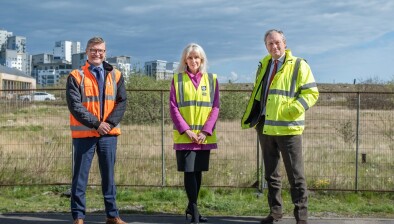Edinburgh harbour developers not entitled to reconveyance of tram route from city council
A property development firm has failed to establish that it was entitled to a reconveyance of a tram line route sold to its predecessors in title that was subsequently re-acquired by the local authority that originally sold it under a compulsory purchase order.

Granton Central Developments Ltd, who were the tenants under a long lease of the land including the tram route, argued that Edinburgh City Council was obligated to convey the route back to them under the term of the original agreement between it and Forth Ports Plc for the sale of the land.
The case was heard in the Outer House of the Court of Session by Lady Wolffe, who issued two opinions relating to separate issues raised by the parties. The pursuer was represented by Campbell QC and the defender by Burnet QC.
Connected obligations
The defender entered into an agreement under section 75 of the Town and Country Planning (Scotland) Act 1997 with Forth Ports in respect of a 33-hectare area of land forming part of a development site at Granton Harbour, Edinburgh. Part of that land was acquired by the pursuer in June 2014, at which time it transferred title to some of that land to its funder, “Alpha”, and became the tenant of that land under a long lease from them.
Part of the land sold to the pursuer and then transferred to Alpha included a proposed tram line route (TLR) for which outline planning permission had been granted by the defender. The TLR was then re-acquired by the defender by virtue of a general vesting declaration under section 195 of the 1997 Act in May 2016. As a consequence of this, the defender paid Alpha £299,000 for its interest in the TLR, of which it paid £99,550 to the pursuer in respect of its interest as tenant.
It was agreed between the parties that, under the Crichel Down Rules, where land that has been acquired by compulsory purchase became surplus to the requirements the former owners would be given a first opportunity to repurchase the land previously in their ownership. The pursuer asserted that under these rules it was entitled to a reconveyance of the TLR from the defender.
Under Clause 5.4 the original agreement between Forth and the defender, the Council was to re-convey the TLR back to Forth following acquisition if construction of the tram line had not commenced by 1 January 2020. It was submitted for the pursuer that this was a free-standing obligation which transferred to them as Forth’s successor in title.
In response, the defender submitted that there was no reference to successors to Forth in the agreement, which directly referred to a re-conveyance to Forth by the Council and was linked intrinsically to Clause 5.2 of the agreement, which required Forth to convey the land to the Council upon receipt of appropriate notice. The agreement therefore required to be construed as a whole.
No reconveyance without conveyance
In her first opinion, Lady Wolffe said of the original agreement between the defender and Forth Ports: “The Agreement was entered into to achieve a purpose which is extrinsic to it, namely, to facilitate the development of the Site and to secure the planning gains in relation to it. The Council’s objective in entering into it was to secure planning gains from the counterparty, Forth.”
She continued: “Accordingly, the Agreement falls to be construed consistently with these planning purposes and in the context that the grant of outline planning permission was predicated on Forth entering into the Agreement.”
Addressing the potential connection between Clauses 5.2 and 5.4, she said: “As is clear from Clause 5.2, the Council had the option to secure the TLR at no cost, but only if it was ‘required’ to construct the tram line. What was to happen if the Council exercised the option in Clause 5.2, but then failed to commence the TLR within the anticipated timeframe? In my view, the Agreement anticipated this scenario and provided for it in Clause 5.4.”
She further explained: “Each clause commences with the same provisional phrasing, ‘[i]n the event that …’, and each contingency is tied to the same longstop date (of 1 January 2020). The use of the word “convey in Clause 5.2 and ‘re-conveyed’ in Clause 5.4 further reinforces the analysis that Clause 5.4 is dependent on the exercise of the option embodied in Clause 5.2. There can be no ‘re-conveyance’ if there has not been an original conveyance.”
Examining the effect of the pursuer’s interpretation of the clause would have under the Crichel Down Rules, Lady Wolffe said: “The Council would in effect have paid something for nothing, in the form of the compensation it has already paid to Forth to acquire the TLR but (if the pursuer’s interpretation of clause 5.4 were correct) followed by return of the TLR at no cost to Forth (or, if the pursuer is correct, to it). This would defeat the financial parity which is a feature of the Rules and which parties also contracted for in the provisions that any transfer under clauses 5.2 and 5.4 were both ‘at no cost’.”
Turning to whether the pursuer could be substituted for Forth and the words “and their successors” added to Clause 5.4, she said: “Contrary to Mr Campbell’s submission that the omission of these words was attributable to inept drafting, their omission may in fact reflect the fact that terms of Clause 5.4 was a counterpart to Clause 5.2. In other words, if there is no right under Clause 5.4 capable of transmission to a third party successor to Forth, then it would be otiose to provide otherwise.”
For these reasons, Lady Wolffe held that the pursuer’s case as predicated on its contractual interpretation argument was irrelevant. A separate opinion was issued addressing whether the pursuer had title to sue.














